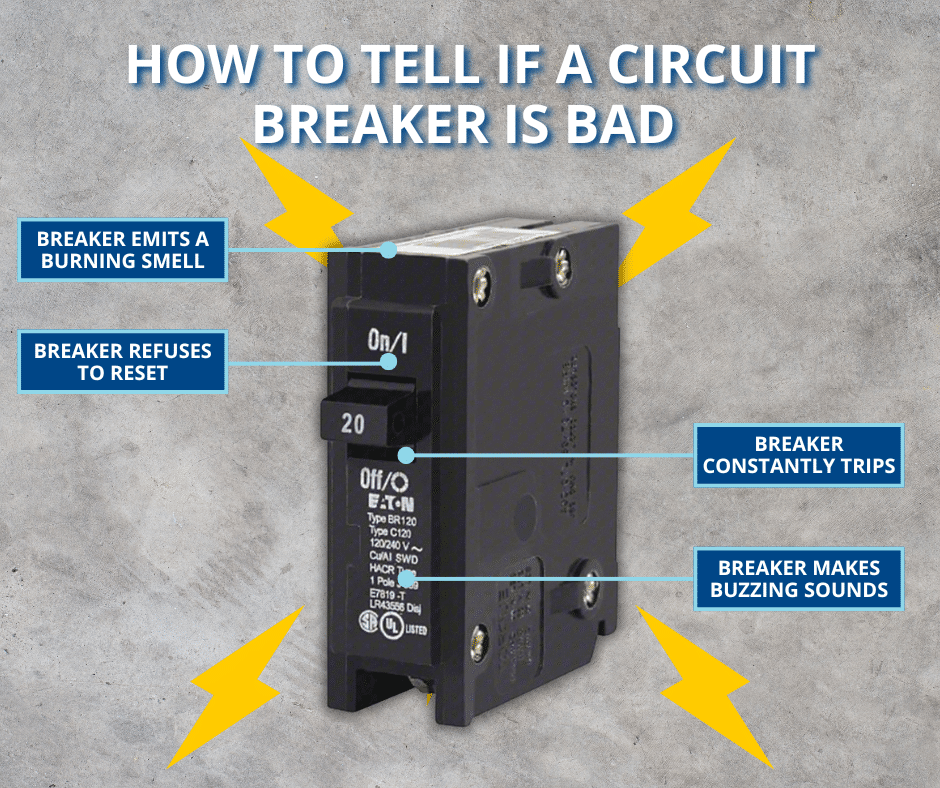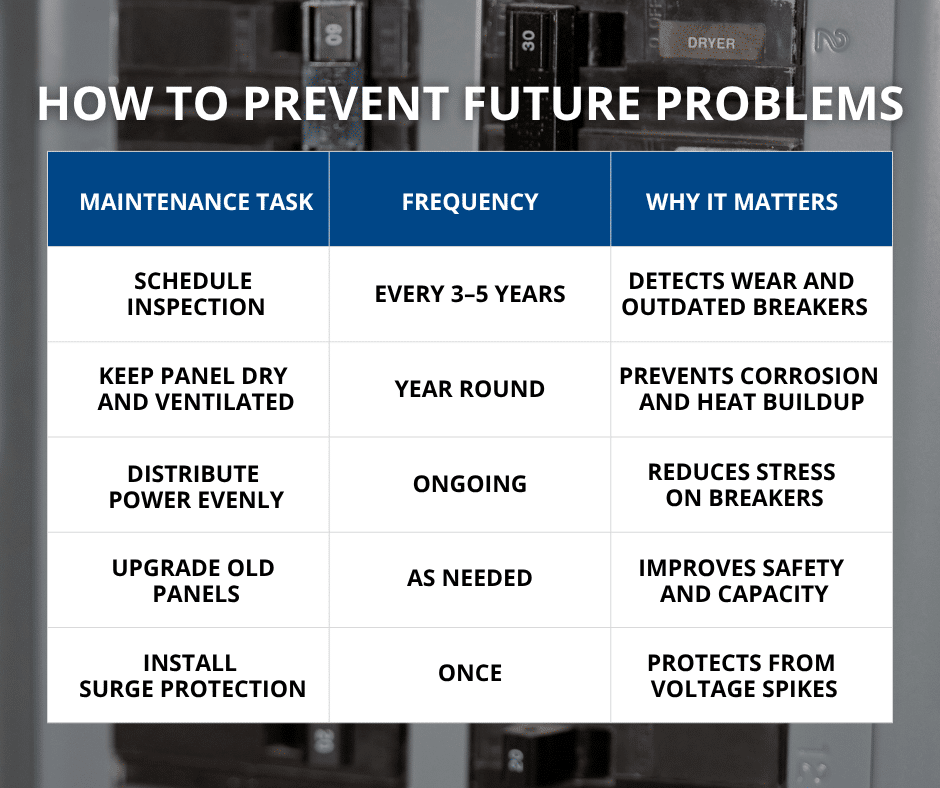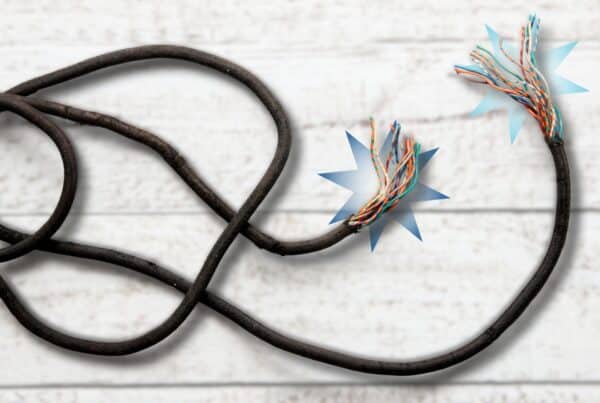
Knowing how to tell if a circuit breaker is bad can save you from costly electrical repairs and serious safety risks. Faulty breakers can cause flickering lights, random power loss, or even lead to electrical fires.
Fortunately, most problems show warning signs before they become dangerous.
This guide will walk homeowners through how to recognize a bad circuit breaker, what causes it to fail, and how to prevent future issues in your home’s electrical system.
What a Circuit Breaker Does and Why It Matters
According to the Electrical Safety Foundation International, home electrical fires account for an estimated 51,000 fires each year in the U.S. alone.
A circuit breaker is a safety device designed to protect your home’s wiring and appliances from too much electrical current. When a circuit gets overloaded, the breaker automatically trips, cutting off power before wires overheat or start a fire.
Each breaker controls a specific section of your home, like the kitchen, bedrooms, or garage. When one fails, it can leave part of your home without power or make your electrical system unsafe.
A bad breaker doesn’t always stop working completely. It may trip too often, not trip when it should, or fail to reset properly.
Recognizing these early signs can help you avoid damage and maintain a safe home.

How to Tell If a Circuit Breaker Is Bad
1. Is the breaker constantly tripping for no obvious reason?
If a breaker trips often without heavy use on that circuit, it could be malfunctioning. While occasional tripping during high energy use is normal, a breaker that shuts off repeatedly might have worn internal parts or a weak connection.
Try unplugging everything and resetting it. If it still trips, it’s likely failing internally.
2. Does the breaker switch feel hot or emit a burning smell?
A warm breaker or a faint burning smell indicates overheating. This usually means poor electrical contact or corrosion within the breaker.
If you smell burning plastic or the breaker feels unusually hot, turn off the power if it’s safe to do so and contact a professional.
Continuing to use an overheated breaker increases fire risk.
3. Does the breaker refuse to reset or stay in the ON position?
A healthy breaker should click firmly into place when reset and stay on. If it immediately flips back to OFF or won’t hold position, the internal mechanism might be worn out.
Avoid forcing it into position; it won’t fix the problem and could cause more damage or create unsafe conditions.
4. Are the lights flickering or certain outlets acting weird on one circuit?
Lights that dim, flicker, or appliances that lose power briefly can indicate that a breaker is struggling to maintain consistent current. These problems may start small but can worsen over time.
Inconsistent power delivery can also harm sensitive electronics, so it’s best to have it checked before more damage occurs.
5. Do you see rust, scorch marks, or hear buzzing sounds?
Rust, discoloration, or buzzing noises coming from your electrical panel are clear signs that something’s wrong. Buzzing or crackling often means electricity is arcing, jumping across small gaps, which creates heat and fire risk.
Corrosion and scorch marks suggest moisture intrusion or damage. These issues should always be handled by a professional immediately.

What Causes a Circuit Breaker to Go Bad
1. Age and Wear
Breakers can last decades, but frequent tripping, moisture exposure, or temperature changes accelerate wear. Over time, the metal parts weaken and may stop functioning correctly.
2. Electrical Overload
Plugging too many high-wattage appliances into one circuit can strain the breaker, especially if this happens often. Repeated overloads weaken the spring and contacts that regulate current flow.
3. Moisture and Corrosion
Panels located in garages, crawl spaces, or near exterior walls are more likely to experience moisture buildup.
Rust or corrosion inside the panel increases resistance, generating heat and making it harder for the breaker to trip properly.
4. Outdated Brands and Designs
Some older breaker brands, such as Federal Pacific and Zinsco, have known safety issues.
These outdated designs may fail to trip under overload, creating serious hazards. If your home still uses one, upgrading your electrical panel is strongly recommended.
5. Manufacturing Defects or Internal Failures
Occasionally, even newer breakers fail because of internal defects or poor-quality parts. When that happens, the breaker may behave unpredictably, tripping when it shouldn’t or not tripping when it should.
How to Safely Check a Suspected Bad Breaker
If you think one of your breakers is bad, follow these safe steps:
- Unplug all devices on that circuit to remove extra load.
- Identify the affected breaker by checking which rooms or outlets lost power.
- Flip the breaker OFF and then ON again.
- If it immediately flips off again, there’s likely a problem.
- Observe the panel. Look for heat, buzzing, or burning smells.
- Avoid opening the panel. Only licensed professionals should inspect wiring inside the box.
If your breaker continues to trip or feels hot even with no load, schedule an inspection immediately.
Common Situations Mistaken for a Bad Breaker
Not every tripping breaker means it’s bad. Here are some common mix-ups:
- Tripped GFCI or AFCI outlets: These safety devices can cut power independently of the breaker.
- Circuit overload: Using too many appliances on one circuit causes legitimate trips.
- Faulty appliances: Malfunctioning equipment can pull too much current, mimicking a bad breaker.
- Loose or damaged wiring: Fluctuating connections can interrupt power even if the breaker is fine.
An experienced home inspector can identify the root cause and prevent unnecessary replacement.
How to Tell If a Breaker Is Bad Without Tools
Even without specialized tools, you can still recognize a failing breaker.
- The switch feels loose or doesn’t “click” firmly.
- The breaker trips immediately after resetting.
- Affected outlets lose power inconsistently.
- The breaker feels warm or emits a smell of burnt plastic.
If any of these happen, the safest move is to stop using the circuit until a professional can assess it.
Safety Risks of Ignoring a Bad Breaker
A damaged breaker can create multiple hazards:
- Fire risk: Overheating or electrical arcing may ignite insulation or nearby materials.
- Shock hazard: Unstable electrical flow can make outlets unsafe to touch.
- Appliance damage: Fluctuating voltage can destroy electronics or shorten appliance lifespan.
- Unexpected power loss: Losing power in part of your home can disrupt daily life and mask deeper wiring problems.
What to Do When You Suspect a Bad Breaker
If you think a breaker is failing, take these steps before calling for help:
- Label the affected circuit. Write down which outlets, switches, or rooms are losing power. This helps inspectors trace the issue quickly.
- Unplug electronics and appliances. Reduces stress on the circuit and prevents damage to sensitive devices.
- Perform one reset test. Turn the breaker completely OFF, then ON again once. If it trips right away or won’t stay ON, stop there.
- Visually inspect your panel. Without opening it, check for moisture, rust, or discoloration.
- Monitor for patterns. Notice whether it happens after using certain appliances or during storms. These patterns can point to either a bad breaker or wiring issues.
- Call for a professional inspection. Even if you can reset the breaker, repeated tripping means the problem will likely return. An inspector or electrician can test current flow and identify whether replacement or repair is needed.
Taking careful notes and acting quickly protects both your home and your family. It also helps your inspector pinpoint the cause faster, saving you time and money on unnecessary repairs.
Preventing Future Breaker Problems
While some breaker failures are unavoidable, you can take steps to extend their life and prevent future issues:

By following these preventive measures, you’ll ensure your home’s electrical system remains efficient and reliable. A few simple steps each year can extend your panel’s lifespan and minimize costly emergency repairs.
Related Questions
Can a breaker go bad without ever tripping?
Yes. Breakers can fail internally without obvious signs. They may continue delivering unstable current, which can slowly damage appliances.
Can a bad breaker cause partial power loss?
Yes. A weak breaker can cause some outlets or lights on the same circuit to lose power while others work fine.
How long do circuit breakers last?
Typically 20 to 40 years, depending on usage and environment. Electrical panels exposed to heat or humidity may need attention sooner.
Should I replace all breakers at once?
If your panel is outdated or contains unsafe brands, replacing all breakers may be wise. Otherwise, only replace those showing problems.
Can I replace a breaker myself?
Replacing a breaker involves working near live power. It’s best to leave this task to a licensed professional who can ensure proper installation and safety compliance.
When to Call a Professional
If your breaker trips repeatedly, feels warm, or shows visible signs of damage, don’t delay calling for help. Professionals have the equipment to test voltage, check wiring, and identify if a breaker or another part of your electrical system is at fault.
At Boggs Inspection Services, our team inspects electrical panels during full home evaluations. We identify potential hazards, measure load capacity, and verify that your home meets modern safety standards.
Due to the region’s wet climate and many older homes, breaker corrosion and panel aging are common issues for Olympia homeowners.
Conclusion
Understanding how to tell if a circuit breaker is bad helps you keep your home safe and your electrical system reliable. By learning the common signs like frequent tripping, heat, burning smells, or flickering lights, you can act before small issues turn into serious hazards.
Our certified inspectors evaluate electrical panels, test breaker function, and make safety recommendations specific to your home.
Contact us today to schedule your inspection and protect what matters most.



